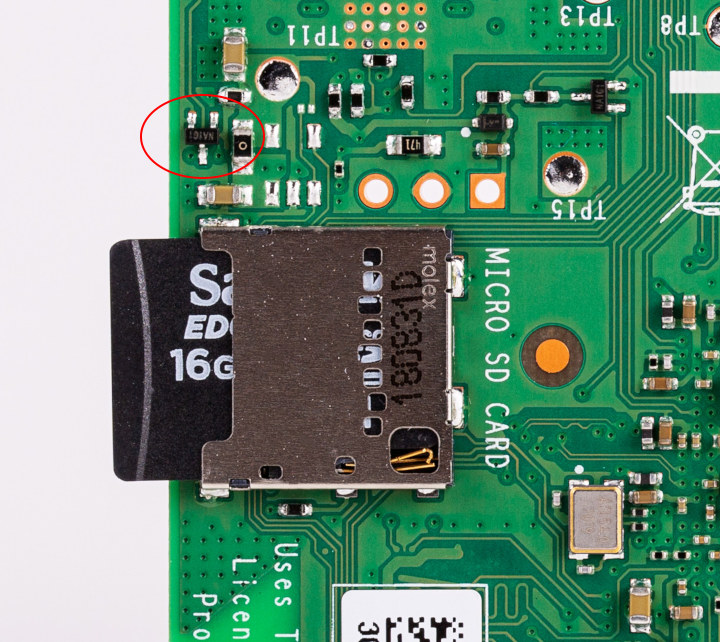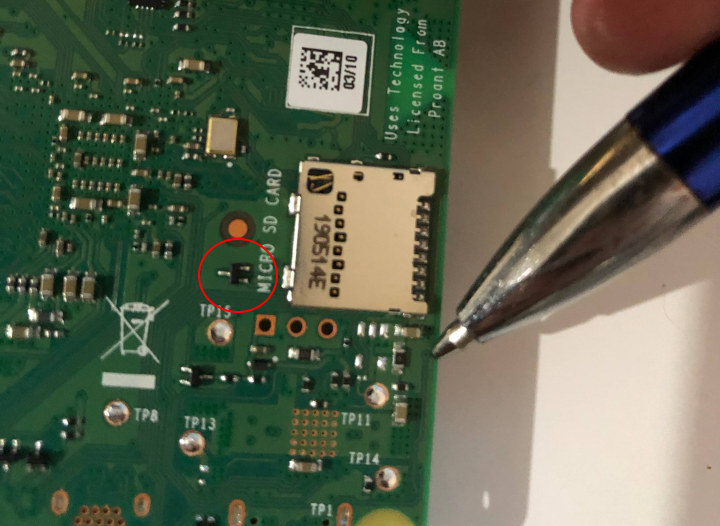The first Raspberry Pi 4 boards suffered from a poor USB-C power supply compatibility due to issues for the power circuitry. That means if you bought the official USB-C power supply you had no issues, but if you wanted to re-use a spare USB-C power supply or incompatible cable, you may be out of luck.
The Register is now reporting that the Raspberry Pi Foundation has discreetly released a new revision (v1.2) of the board that fixes several issues including USB-C PD compatibility, and as Eben Upton explains the new revision also:
moved the WLCSP SD card voltage switch to the top side
… silk screen tweaks to reduce solder bridging in manufacture”.
The new boards have been around for a couple of months as some users report the USB-C power issues have been fixed on new boards.
Spotting Differences in the new Raspberry Pi 4 Rev 1.2 Board?
The bad news is if you buy the board online, nobody is advertising about the new revision. If you buy in a brick-and-mortar store, there aren’t obvious differences, and the silkscreen markings are apparently the same, but you can check the new location of the WLCSP SD card voltage switch.


They moved the switch because some people would inadvertently unsolder it in the original version of the board while trying to insert the MicroSD card.
Another way is to check the revision in the command line with cat /proc/cpuinfo
That’s the output from Rev 1.2 board:
|
1 2 3 4 5 6 7 8 9 10 11 12 13 14 |
root@pi4:/home/pi# cat /proc/cpuinfo processor : 0 model name : ARMv7 Processor rev 3 (v7l) BogoMIPS : 108.00 Features : half thumb fastmult vfp edsp neon vfpv3 tls vfpv4 idiva idivt vfpd32 lpae evtstrm crc32 CPU implementer : 0x41 CPU architecture: 7 CPU variant : 0x0 CPU part : 0xd08 CPU revision : 3 ... Hardware : BCM2835 Revision : c03112 Serial : 10000000c3ed3713<code> |
If the revision reads “c03112” that means you are the lucky owner of a Raspberry Pi 4 Rev 1.2 board. My board has “Revision : a03111” instead. with the first non-zero a, b, c digit referring to the amount of memory (1GB, 2GB, 4GB RAM). You can learn how to decode Raspberry Pi revision codes here.

Jean-Luc started CNX Software in 2010 as a part-time endeavor, before quitting his job as a software engineering manager, and starting to write daily news, and reviews full time later in 2011.
Support CNX Software! Donate via cryptocurrencies, become a Patron on Patreon, or purchase goods on Amazon or Aliexpress. We also use affiliate links in articles to earn commissions if you make a purchase after clicking on those links.




> if you wanted to re-use a spare USB-C power supply you may be out of luck
It isn’t about power supplies but USB-C cables. Only the more expensive e-marked ones with a small chip inside don’t work with the early RPi 4 revisions.
https://e2e.ti.com/cfs-file/__key/communityserver-blogs-components-weblogfiles/00-00-00-03-25/2577.USB_2D00_C-image-1.png
> WLCSP SD card voltage switch
Thanks for mentioning this. Wasn’t aware that the RPi 4 is able to switch SD card voltage and is capable of DDR50 speed (twice as fast as before without ‘overclocking’ the SD card controller).
Worth noting that the RPF(T) have almost never announced board revisions, only major model changes. So claiming “discretely” or “secretly” for this one seems odd as it always been done like this.
I brought the RPI4 last November and I just found out that it is this revision. I don’t know about the power supply thing because I used a regular usbc cable with a 18w adapter and it doesn’t power on. I had t use a special usb c power supply for this.
Do tell, where did you procure this advanced model?
A fast/smart charger will not work, b/c they only output 1A or so to a dumb device and the pi is dumb as hell LOL (I assume that’s what you used).
I use a dual 2.4A dumb charger from anker with Y cable (shortest, beefiest looking Y you can find for cheap and 3ft quality USB charging cable like anker).
Hackaday will talk you through it
” Exploring The Raspberry Pi 4 USB-C Issue In-Depth ”
” It would be fair to say that the Raspberry Pi team hasn’t been without its share of hardware issues, with the Raspberry Pi 2 being camera shy, the Raspberry Pi PoE HAT suffering from a rather embarrassing USB power issue, and now the all-new Raspberry Pi 4 is the first to have USB-C power delivery, but it doesn’t do USB-C very well unless you go for a ‘dumb’ cable.
Join me below for a brief recap of those previous issues, and an in-depth summary of USB-C, the differences between regular and electronically marked (e-marked) cables, and why detection logic might be making your brand-new Raspberry Pi 4 look like an analogue set of headphones to the power delivery hardware. “
This is linked in the introduction.
I was disappointed to receive an old revision pi4 from Farnell today. If this is important to you I’d wait a bit longer until impatient people like me clear out the old stock.
Good article thanks.
I have the 1.2 version and it tells you what version you have in the last line of the output of the cat /proc/cpuinfo…no need to decode anything
Each digit in the revision number has a meaning. So you can derive the amount of memory, who produced the board, the version, etc… from the revision in cpuinfo.
I am not convinced. Are you sure, this this the change mentioned? Since the highlighted component is clearly some SOT-23 transistor oř whatever, not WLCSP switch. WLCSP (Wafer level chip scale package) is like really small BGA IC – no pins sticking on chip sides. I am pretty sure, there are more significant changes elsewhere. On the other side od the board maybe?
To be honest, I was confused by that too, but that’s the only chip that could potentially be damaged by inserting the MicroSD card, and that’s the only one I could see was moved. I checked both sides.
I have an older revision pi4 and I count three WLCSP chips on it. Two are protection chips over by the HDMI ports. The third is on the bottom side of the board near the corner of the main SoC towards the WiFi can. Could that be the chip in question? From your picture of the bottom side of the new one, the WLCSP chip is indeed missing.
The question of how you could unsolder it while inserting a micro SD card remains puzzling. I assume it must have been by shorting out something and having the device overheat?
Hy! On my RPi4 Board this switch broke, but i dont see any difference in functionality. Everything works like before
> i dont see any difference in functionality
See above. When the SD card controller is able to switch voltages between 3.3V and 1.8V the cards are able to reach faster modes, in this case DDR50. Without this your SD card is limited to ~23MB/s sequential speeds and also random IO performance is negatively affected.
Worse yet, if the SoC tells the card to go to 1.8V mode and *doesn’t switch the power* in a fairly short interval, the spec says you might fry the card. If you don’t have a UHS-I card, then it may not try to go into high speed mode and you would see no difference. If you had a 1.8V capable UHS-I card, there’s not guarantee that it would keep working.
Thanks for clarifying that’s it not just a matter of (lower) speed but potential destruction when using ‘better’ SD cards.
If you have access to the full SD spec, it’s in section 4.2.4.2. I only have the free spec and it says what’s supposed to be in the section, but no details.
That’s definitely not a WLCSP nor is it the part which moved to the top. On a 1.1 board, there’s a WLCSP just near the oscillator behind the SD slot. On the 1.2, that goes on top at the corner of the SoC.
Looking at the link about the revisions, I can see only the 2GB RAM and 4GB RAM boards get the fix. Not surprising, as they’ll basically drop the 1GB version with the $35 price tag for the 2GB version: https://www.cnx-software.com/2020/02/27/raspberry-pi-4b-2gb-ram-price-drop/
More so, I think this ties into what Mookid and theukguy were talking about in the price change thread. They might have left the 1GB model alone as that’s the one they promised to LTS for industry.
is it possible to modify older boards to fix the USB-C problem?
> fix the USB-C problem?
Sure, don’t use an expensive USB-C cable but some cheap junk and you’re done.
That’s not fixing it, that’s working around it.
to find rpi version just run this:
cat /proc/device-tree/model
Did they not put the hardware revision on the board itself in the silkscreen, like every hardware engineer ever knows they’re supposed to do?